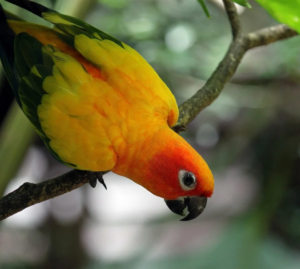
Sun conures are a very popular pet due to their size and wide availability. But we are only recently learning more about their wild nature and behaviors. The only place to see wild sun parakeets (Aratinga solstitialis) is primarily near the village of Karasabai in the country of Guyana. There are more sun parakeets in Brazil but they are difficult to see because they are in Indigenous Territories where entrance by visitors is heavily restricted. By the way, small to medium-sized birds with long tails are referred to as parakeets in South America.
Guyana is a small country just north and east of Brazil and east of Venezuela. It is considered part of the Commonwealth Caribbean (which includes the English-speaking islands, Belize, and Guyana). Guyana is an indigenous term that means “Land of Many Waters.” It also has one of the largest unspoiled rainforests, mostly because it does not have modern transportation and cannot be easily traveled, except by the people who live in the forest.

In 2021, the sun parakeet was listed as endangered by the IUCN Red List of Threatened Species with an estimated remaining population between 1000-2499. The sun parakeet is possibly even extinct in a substantial part of its former range. The threats are the usual ones – livestock ranching, farming, logging, and trapping. The sun parakeet was heavily trapped and exported in the 1970s and 1980s. While trapping of the sun parakeet is illegal in Guyana and Brazil now, it still goes on, especially for markets in Malaysia and Asia. Its range has been severely reduced in Guyana. There used to be tens of thousands in the savannah and now they are only left in Karasabai.
The sun parakeet is mostly observed in the hilly and mountainous areas, but it often feeds in forested valleys. The parakeet rangers have documented 15 different species of plants that they eat, the most common is monkey brush which has brilliant yellow and red flowers (the perfect camouflage!). According to several studies in the 1980s, including references from the famed Joseph Forshaw, they also eat a variety of wild seeds and fruits, especially Melastomataceous flowering plants in the flooded forests. This parakeet is usually found in small community flocks, but very little has been known about its breeding, nesting, and migratory behaviors until recently.
In September 2022, Dr. LoraKim Joyner from One Earth Conservation journeyed to Karasabai, Guyana along with representatives from the U.S. Fish and Wildlife Service (USFWS) and the U.S. Forest Service (USFS). These agencies were able to help with advice and some grant support through the USAID Caribbean Grant program. Especially helpful, the USFS led a tree-climbing workshop so that local rangers could learn to search out this conure’s tree and nest cavities for the first time.

In March 2023, the newly trained parakeet rangers of Karasabai climbed their first active sun parakeet nests. Since so little has been known about the species in the wild, this was the start of intensive observation and data collection. It turns out the ecology of sun parakeets varies greatly from other South American parrots like macaws and Amazons. For example, unlike most parrots, it roosts and nests in the same tree cavity. So, if you see a sun parakeet in a tree cavity, it does not mean it is an active nest with chicks, it may just be used for sleeping. Many suns can come and go from the same cavity, making it hard to know if the same birds are involved, or if an individual has a variety of roosting sites and companions. As of October 2022, 37 cavities had been identified, 15 were confirmed to be for roosting only. The other 22 were potential nesting cavities. There are now 59 confirmed cavities based on recent observations.

The sun parakeet normally has a 9-week breeding cycle. It has recently been determined that they have eggs or chicks in the cavities between January and October. Active nests also include parakeets of varying ages – fledglings, juveniles, eggs, chicks, and often multiple adults. There seems to be a community, with females mating or being fed by more than one male and even juveniles feeding younger birds. They appear to be cooperative breeders with likely extra-pair couplings. But we just don’t know for sure! There is an ongoing DNA study in Karasabai. Clearly there is much more to learn about this loud and beautiful parrot in the wild, given its community attributes and unusual breeding patterns.

This month’s Lafeber grant goes to support the Karasabai local rangers through One Earth Conservation. You can learn more about their good works here: https://www.oneearthconservation.org/sun-parakeet
